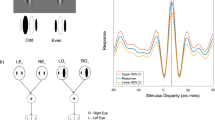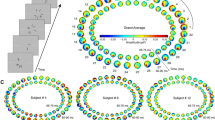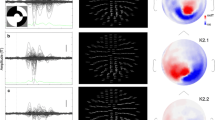Abstract
A systematic study was made of visual evoked responses to dynamic random dot stimuli containing controllable, monocularly visible contrast cues. Ratios of dot densities for the centrally presented, disparate figure and the background were varied in steps of 1/8 maximum density between 0/8 and 8/8. The figure was either a square or an equivalent area of nebulous shape. A 30-arc min disparity was compared with binocular nondisparate and monocular conditions. Evoked responses (scalp sites 02, 01, T6, T5) were averaged for each of 24 disparity-contrast-shape conditions. At all contrast levels, response amplitudes and latency over the left hemisphere was significantly greater than over the right hemisphere. For 30 arc min disparity, amplitudes in the 8/8 condition were significantly smaller than in conditions where stimulus/background contrast could afford monocular depth cues. Hemisphere amplitude differences diminished as contrast decreased. Factor analyses isolated two overlapping components in the response to disparate stimuli. The earlier, at 236 ms latency, may index the stereoscopic stimulus features. The later, at 295 ms, peaking at maximum contrast and present in all suprathreshold nondisparity conditions, may index contrast features of the stimulus. The results indicate the importance of controlling dot density ratios in electrophysiological studies of the stereoscopic response to random dot stimuli.
Similar content being viewed by others
References
Dunlop DB, Dunlop P, Fenelon B and Neill RA (1983) Evoked responses to distinct and nebulous stereoscopic stimuli. Aust J Ophthalmol 11:295–301
Fenelon B, Neill RA and Manning ML (1984) Stereoscopic cerebral evoked potentials of air force pilots and civilian comparison groups. Avait Space Environ Med 55:914–920
Fenelon B, Neill RA and White CT (in press) Evoked potentials (EP) to dynamic random dot stereograms in upper, centre and lower fields. Doc Ophthalmol
Neill RA and Fenelon B (1981) The objective evaluation of stereopsis. Australasian Phys Eng Sci Med 4:122–125
Neill RA and Kennewell JA (1979) A clinical test for stereopsis. Australasian Phys Sci Med 2:463–480
Author information
Authors and Affiliations
Rights and permissions
About this article
Cite this article
Neill, R.A., Fenelon, B., Manning, M.L. et al. Evoked potentials to dynamic random dot stimuli with varying dot density ratios of disparity to background. Doc Ophthalmol 63, 407–415 (1986). https://doi.org/10.1007/BF00220233
Issue Date:
DOI: https://doi.org/10.1007/BF00220233




